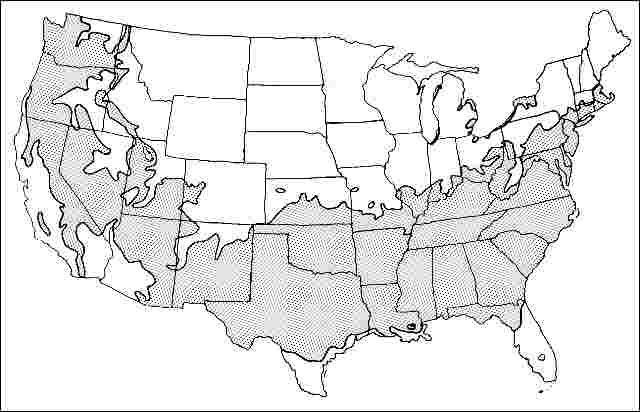Introduction
This striking evergreen forms a loose, open, pyramidal shape of somewhat pendulous branches clothed with dense, short, light green to blue/green, fragrant needles. Trees reach 30 to 40 feet in height by 15 to 20 feet in width, and develop a somewhat oval canopy with age. The trunk remains straight with relatively small-diameter lateral branches. Long branches are spaced just far enough apart to allow the handsome, reddish-brown, peeling bark to be easily seen when standing next to the tree. The short needles may take on a slight bronze hue in winter but will quickly return to green in springtime. The foliage of this cultivar discolors in winter far less than the species.

Credit: Ed Gilman, UF/IFAS
General Information
Scientific name: Cryptomeria japonica
Pronunciation: krip-toe-MEER-ee-uh juh-PAWN-ih-kuh
Common name(s): 'Yoshino' Japanese cedar
Family: Taxodiaceae
USDA hardiness zones: 6A through 8B (Fig. 2)
Origin: not native to North America
Invasive potential: little invasive potential
Uses: screen; specimen; parking lot island < 100 sq ft; parking lot island 100–200 sq ft; parking lot island > 200 sq ft; tree lawn 3–4 feet wide; tree lawn 4–6 feet wide; tree lawn > 6 ft wide; urban tolerant; highway median; bonsai
Availability: somewhat available, may have to go out of the region to find the tree

Description
Height: 30 to 40 feet
Spread: 15 to 20 feet
Crown uniformity: symmetrical
Crown shape: pyramidal
Crown density: dense
Growth rate: slow
Texture: fine
Foliage
Leaf arrangement: spiral (Fig. 3)
Leaf type: simple
Leaf margin: entire
Leaf shape: awl-like
Leaf venation: none, or difficult to see
Leaf type and persistence: evergreen
Leaf blade length: less than 2 inches
Leaf color: green
Fall color: copper
Fall characteristic: not showy

Flower
Flower color: unknown
Flower characteristics: not showy
Fruit
Fruit shape: round
Fruit length: .5 to 1 inch
Fruit covering: dry or hard
Fruit color: brown
Fruit characteristics: does not attract wildlife; not showy; fruit/leaves not a litter problem
Trunk and Branches
Trunk/bark/branches: branches droop; very showy; typically one trunk; thorns
Pruning requirement: little required
Breakage: resistant
Current year twig color: green
Current year twig thickness: medium
Wood specific gravity: unknown
Culture
Light requirement: full sun, partial sun, or partial shade
Soil tolerances: clay; sand; loam; acidic; well-drained
Drought tolerance: moderate
Aerosol salt tolerance: unknown
Other
Roots: not a problem
Winter interest: no
Outstanding tree: yes
Ozone sensitivity: unknown
Verticillium wilt susceptibility: resistant
Pest resistance: resistant to pests/diseases
Use and Management
'Yoshino' Japanese cedar makes a dramatic landscape element for an open lawn or can be used as an attractive street tree, particularly for narrow spaces. For street tree use, remove lower branches at an early age to keep the pruning scars as small as possible. It may grow too large for most residential landscapes but makes a nice specimen or 'softening' tree for a large building.
'Yoshino' Japanese cedar should be grown in full sun, sheltered from harsh winds, on well-drained, moist, acid soil. Locate it so air circulation around the tree is good, particularly during the summer, to help prevent leaf blight. It thrives best with some afternoon shade in the southern part of its range. Although plants may grow 2- to 4-feet per year when young, they will rarely require pruning if properly located in the landscape as they naturally grow into a beautiful pyramidal shape. 'Yoshino' Japanese cedar and the species are tolerant of compacted soil and probably perform well in parking lots and other tough urban sites, with some irrigation in drought.
Propagation is by cuttings from mature wood.
Pests and Diseases
No pests or diseases are of major concern but occasionally bothered by leaf blight and leaf spot, but probably less so than the species. Mites can infest the foliage.